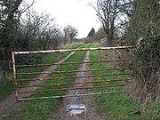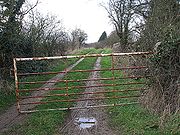
Radclive Halt railway station
Encyclopedia
Radclive Halt was a railway station on the Banbury to Verney Junction Branch Line
which served the village of Radclive
in Buckinghamshire
, England
, from 1956 to 1961.
to Buckingham
section of the Banbury to Verney Junction branch line was chosen as the location for a single railcar
experiment to encourage greater passenger patronage on the branch which was suffering from low receipts in the face of competition from buses and motor cars. The experiment formed part of the 1955 Modernisation Plan. The units would run from Banbury to Buckingham where a connection would be made with the traditional steam push-pull service
to Bletchley
.
New halts were opened at Radclive and Water Stratford
and a third was proposed on the edge of Buckingham but not provided. The two halts were constructed of timber with old sleepers
forming the platform surface; unlike the other stations on the line, the halts were constructed to standard train height and one car in length. They were equipped with little other than a simple wooden painted nameboard and several old LNWR
oil lamps; there was no shelter for passengers nor even a bench. The lamps were lit by the Brackley
stationmaster.
 The two British Rail Derby Lightweight
The two British Rail Derby Lightweight
railcars, nos. M79900 and M79901, resulted in a reported 400% increase in traffic and were well used especially on market days and Saturdays when both ran together, carrying up to 120 passengers. Despite the increased revenue and reduction in costs, the railcars were unable to save the Banbury - Buckingham section from closure on 2 January 1961, with British Rail
claiming that although the cars were well used during peak times, they ran empty at normal times. According to published figures, the line had been losing £14,000 per annum before the experiment with receipts of around £50 per month; the railcars resulted in an increase in the income of around £250 - £300 per month, but still ran at a loss of £400 per month and the annual loss on the line could not be reduced beyond £4,700.
Banbury to Verney Junction Branch Line
The Banbury to Verney Junction Branch Line was a railway branch line constructed by the Buckinghamshire Railway which connected the Oxfordshire market town of Banbury with the Buckinghamshire town of Bletchley via the historic county town of Buckingham and the Northamptonshire town of Brackley, a...
which served the village of Radclive
Radclive
Radclive is a village on the River Great Ouse just over west of Buckingham in Buckinghamshire, England. It is in the civil parish of Radclive-cum-Chackmore in Aylesbury Vale district...
in Buckinghamshire
Buckinghamshire
Buckinghamshire is a ceremonial and non-metropolitan home county in South East England. The county town is Aylesbury, the largest town in the ceremonial county is Milton Keynes and largest town in the non-metropolitan county is High Wycombe....
, England
England
England is a country that is part of the United Kingdom. It shares land borders with Scotland to the north and Wales to the west; the Irish Sea is to the north west, the Celtic Sea to the south west, with the North Sea to the east and the English Channel to the south separating it from continental...
, from 1956 to 1961.
History
During the summer of 1956 the BanburyBanbury Merton Street railway station
Banbury Merton Street was the first railway station to serve the Oxfordshire market town of Banbury in England. It opened in 1850 as the northern terminus of the Buckinghamshire Railway providing connections to Bletchley and Oxford and closing for passengers in 1961 and goods in 1966.- Context...
to Buckingham
Buckingham railway station
Buckingham was a railway station which served Buckingham, the former county town of Buckinghamshire, England, between 1850 and 1966.- Opening :...
section of the Banbury to Verney Junction branch line was chosen as the location for a single railcar
Railcar
A railcar, in British English and Australian English, is a self-propelled railway vehicle designed to transport passengers. The term "railcar" is usually used in reference to a train consisting of a single coach , with a driver's cab at one or both ends. Some railways, e.g., the Great Western...
experiment to encourage greater passenger patronage on the branch which was suffering from low receipts in the face of competition from buses and motor cars. The experiment formed part of the 1955 Modernisation Plan. The units would run from Banbury to Buckingham where a connection would be made with the traditional steam push-pull service
Push-pull train
Push–pull is a mode of operation for locomotive-hauled trains allowing them to be driven from either end.A push–pull train has a locomotive at one end of the train, connected via some form of remote control, such as multiple-unit train control, to a vehicle equipped with a control cab at the other...
to Bletchley
Bletchley railway station
Bletchley is a railway station that serves the southern districts of Milton Keynes , and the north-eastern parts of the Buckinghamshire district of Aylesbury Vale....
.
New halts were opened at Radclive and Water Stratford
Water Stratford Halt railway station
Water Stratford Halt was a railway station on the Banbury to Verney Junction Branch Line which served the village of Water Stratford in Buckinghamshire, England, from 1956 to 1961.- History :...
and a third was proposed on the edge of Buckingham but not provided. The two halts were constructed of timber with old sleepers
Railroad tie
A railroad tie/railway tie , or railway sleeper is a rectangular item used to support the rails in railroad tracks...
forming the platform surface; unlike the other stations on the line, the halts were constructed to standard train height and one car in length. They were equipped with little other than a simple wooden painted nameboard and several old LNWR
London and North Western Railway
The London and North Western Railway was a British railway company between 1846 and 1922. It was created by the merger of three companies – the Grand Junction Railway, the London and Birmingham Railway and the Manchester and Birmingham Railway...
oil lamps; there was no shelter for passengers nor even a bench. The lamps were lit by the Brackley
Brackley railway station
- History :From 1899 until 1963, Brackley was served by two railway stations on different lines. Brackley Central - opened by the Great Central Railway - was the second, the Buckinghamshire Railway having already connected the town to the railway in 1850...
stationmaster.

British Rail Derby Lightweight
The British Rail Derby Lightweight diesel multiple units, were the first such trains to be built en-masse for British Railways. The units were built at BR's Derby Works from 1954 to 1955. The units were built in various formations, including 12 power-twin 2-car units, 84 power-trailer 2-car units,...
railcars, nos. M79900 and M79901, resulted in a reported 400% increase in traffic and were well used especially on market days and Saturdays when both ran together, carrying up to 120 passengers. Despite the increased revenue and reduction in costs, the railcars were unable to save the Banbury - Buckingham section from closure on 2 January 1961, with British Rail
London Midland Region of British Railways
The London Midland Region was one of the six regions created on the formation of the nationalised British Railways and consisted of ex-London, Midland and Scottish Railway lines in England and Wales. The region was managed first from buildings adjacent to Euston Station and later from Stanier...
claiming that although the cars were well used during peak times, they ran empty at normal times. According to published figures, the line had been losing £14,000 per annum before the experiment with receipts of around £50 per month; the railcars resulted in an increase in the income of around £250 - £300 per month, but still ran at a loss of £400 per month and the annual loss on the line could not be reduced beyond £4,700.

